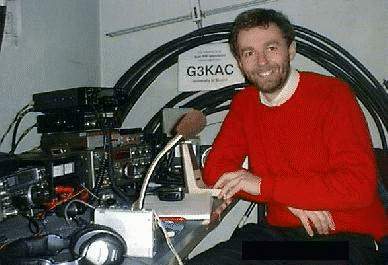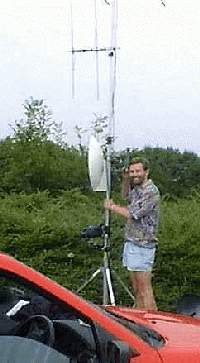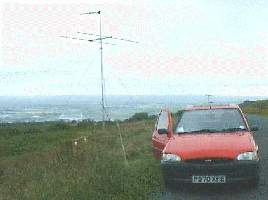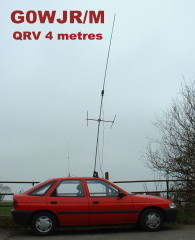Ross J. Wilkinson G0WJR


I was for many years President of the University of Bristol A.R.S and a frequent operator of the Club Stations G3KAC and G8CXH.

My favourite bands are 4m and 2m, but I occasionally operate on most of the others, including portable FM-television in the 1.3, 2.3 and 10.3 GHz bands. I'm a past-Chairman of the Severnside Television Group.

This picture shows me operating on 3cm (10GHz) from Tog Hill, near Bristol. From here I was able to exchange colour pictures and sound with stations on the hills above Cardiff. Not bad for a transmit power of just 10 milliwatts from a Gunn diode!
During 2000, I won the Severnside TV Group's Millennium Trophy for my portable ATV operations.


Since leaving the University, I operate mainly mobile and portable. These pictures show me at Winter Hill, an elevated site on the West Pennine Moors. As the picture shows, on Easter Monday 1999, I was joined there by another six local Amateurs!
I can often be heard on Sunday mornings on the 70MHz Four Metre band especially during the Sunday morning contest sessions. During 1999, I had over 270 QSOs on Four Metres, plus another 220 from G3KAC.
In 2000, I was out portable on most Sunday mornings, from a number of sites around the country, making over 700 QSOs in this mode (the majority of them on 2m and 4m). Have a look at my summary of portable operations in 2000.
Although some of my plans for portable operations in 2001 were thwarted by the dreadful foot-and-mouth disease outbreak, I was still able to work portable or mobile more than 150 times through the year. My new acquisition of a Yaesu FT817 transceiver allowed me to get out and about whenever possible, and I used it for the majority of the 1000-odd contacts I made during the year. Also in 2001, I won a certificate as the leading low-power entrant in the Open section of the RSGB 4m Cumulative contest, which was held in the early months of the year, before the FMD outbreak.
During 2002, I have continued my Sunday morning portable operations, mainly on 4m and 2m, including many "backpacking" expeditions, and was active on microwave ATV during the IARU/BATC contest in September.
I logged around a hundred mobile and portable operating sessions, and made almost three hundred QSOs on Four Metres during the year - more than I did on Two Metres! This picture shows my "mobile" station in November 2002, featuring a vertical half-wave omni and a horizontal 2-ele beam.

Towards the end of 2002, I also did some tests on a number of mobile and portable antenna systems for the lower bands, and have made some successful QSOs with these on 40, 80 and even 160m.
2003 started well, with plenty of fine weather at the weekends. I was able to go out mobile or portable on all but one Sunday through January, February and March. A table of my portable operations can be found here. Note that after Easter, I operated mainly using my original callsign G6GVI.
As well as operating from all over Britain, I have also operated from France as F/G0WJR/P During a holiday in August 1999, I operated on 40m and 20m from near Metz in North-East France. (The main reason for being there was to take part in a hot-air balloon festival.)
During another holiday in Wales in May 1999, I operated as 2C0WJR/P, using a special prefix issued to commemorate the first elections to the new Welsh Assembly. During my stay near Chepstow, I had contacts on the 160, 80, 40, 17, 10, 6, 4 and 2 metre bands.

As well as operating, I have spent a lot of time constructing and modifying equipment for the Amateur bands, including an 80m SSB transceiver, linear transverters for 6m, 4m and 23cm, and a host of PMR conversions for 6m, 4m, 2m and 70cm. A lot of my microwave TV equipment is also home-built, or modified from old satellite receivers and doppler motion detectors.